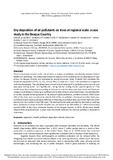JavaScript is disabled for your browser. Some features of this site may not work without it.
| dc.contributor.author | García de Jalón, Silvestre | |
| dc.contributor.author | Burgess, Paul | |
| dc.contributor.author | Curiel Yuste, Jorge | |
| dc.contributor.author | Moreno, Gerardo | |
| dc.contributor.author | Graves, Anil | |
| dc.contributor.author | Palma, João H. N. | |
| dc.contributor.author | Crous-Duran, Josep | |
| dc.contributor.author | Kay, Sonja | |
| dc.contributor.author | Chiabai, Aline | |
| dc.date.accessioned | 2019-08-02T11:31:58Z | |
| dc.date.available | 2019-08-02T11:31:58Z | |
| dc.date.issued | 2019-07-19 | |
| dc.identifier.citation | García de Jalón S, Burgess PJ, Curiel-Yuste J, et al., (2019). Dry deposition of air pollutants on trees at regional scale: a case study in the Basque Country. Agricultural and Forest Meteorology, Volume 278, November 2019, Article number 107648 | en_UK |
| dc.identifier.issn | 0168-1923 | |
| dc.identifier.uri | https://doi.org/10.1016/j.agrformet.2019.107648 | |
| dc.identifier.uri | http://dspace.lib.cranfield.ac.uk/handle/1826/14409 | |
| dc.description.abstract | There is increased interest in the role of trees to reduce air pollution and thereby improve human health and well-being. This study determined the removal of air pollutants by dry deposition of trees across the Basque Country and estimated its annual economic value. A model that calculates the hourly dry deposition of NO2, O3, SO2, CO and PM10 on trees at a 1 km x 1 km resolution at a regional scale was developed. The calculated mean annual rates of removal of air pollution across various land uses were 12.9 kg O3 ha−1, 12.7 kg PM10 ha−1, 3.0 kg NO2 ha−1, 0.8 kg SO2 ha−1 and 0.2 kg CO ha−1. The results were then categorised according to land use in order to determine how much each land use category contributed to reducing air pollution and to determine to what extent trees provided pollution reduction benefits to society. Despite not being located in the areas of highest pollutions, coniferous forests, which cover 25% of the land, were calculated to absorb 21% of the air pollution. Compared to other land uses, coniferous forests were particularly effective in removing air pollution because of their high tree cover density and the duration of leaf life-span. The total economic value provided by the trees in reducing these pollutants in terms of health benefits was estimated to be €60 million yr−1 which represented around 0.09% of the Gross Domestic Product of the Basque Country in 2016. Whilst most health impacts from air pollution are in urban areas the results indicate that most air pollution is removed in rural areas. | en_UK |
| dc.language.iso | en | en_UK |
| dc.publisher | Elsevier Masson | en_UK |
| dc.rights | Attribution-NonCommercial-NoDerivatives 4.0 International | * |
| dc.rights.uri | http://creativecommons.org/licenses/by-nc-nd/4.0/ | * |
| dc.subject | Vegetation | en_UK |
| dc.subject | Pollutant | en_UK |
| dc.subject | Deposition velocity | en_UK |
| dc.subject | Land cover | en_UK |
| dc.subject | Health | en_UK |
| dc.title | Dry deposition of air pollutants on trees at regional scale: a case study in the Basque Country | en_UK |
| dc.type | Article | en_UK |
Files in this item
The following license files are associated with this item:
This item appears in the following Collection(s)
-
Staff publications (SWEE) [2852]

